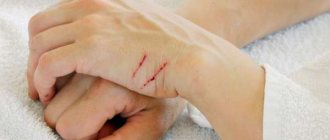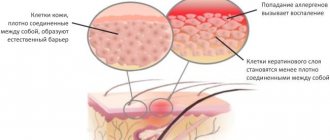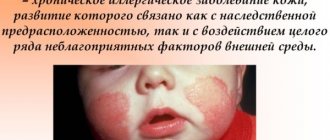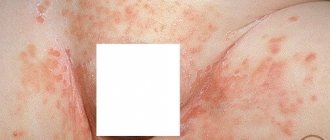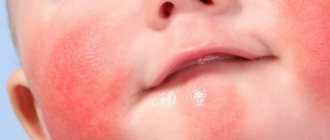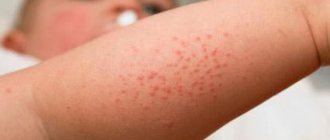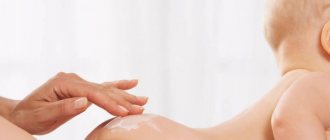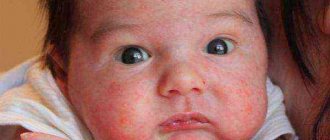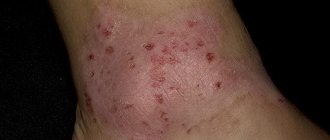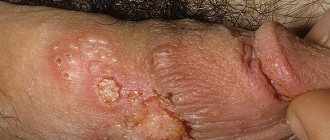What is diaper dermatitis
Diaper dermatitis is an inflammatory reaction of the baby’s skin that occurs when exposed to various external factors. Moreover, each of them can join, thus aggravating the general condition of the baby and the course of the disease. Most often, diaper dermatitis can occur in bottle-fed babies, but according to statistics, about 60% of all babies suffer from this. The period during which diaper dermatitis can develop lasts from birth to 3 years of age, that is, until the child is able to independently control the emptying process. As a rule, the peak age for the development of the disease is 6-12 months.
What does it look like
diaper dermatitis in the photo
Diaper dermatitis, or as it is also called diaper dermatitis, manifests itself in the form of minor abrasions and redness on the surface of the baby’s skin under the diaper (genitals, buttocks, inguinal folds, thighs). Popularly, such manifestations are called diaper rash, and this is the first stage of the development of diaper dermatitis. If not detected and treated in time, then over time the disease will begin to progress, affecting healthy areas on the baby’s body, in which case the following may appear:
- red spots of various shapes and sizes can merge into one spot and spread over large areas of the skin;
- small papules (intradermal blisters);
- peeling;
- crusts;
- wounds and erosive damage.
Dermatitis in an advanced stage may have bubbles with a cloudy liquid on the surface of the skin.
The disease has several characteristic types, manifested in local localization:
- zone of cervical folds - is formed when the baby frequently regurgitates food, in which gastric juice gets onto the skin, where tissue inflammation forms;
- perianal - an inflammatory process around the anus that occurs due to the baby’s nutritional habits and the activity of enzymes from the feces;
- folds in the groin area;
- dermatitis on the genitals - occurs due to the action of urine on the skin.
Treatment methods
Treatment of atopic dermatitis is aimed at eliminating the cause of the disease and symptomatic therapy (effects on the skin, itching, secondary changes). In addition, complications resulting from the disease must be treated. It is impossible to cure dermatitis completely, but it is possible to significantly alleviate the patient’s suffering.
An integrated approach is very important:
- remove allergens from the body and prevent re-exposure;
- local skin treatment;
- systemic (general) treatment.
Medication
Drug treatment can be local and general. Local treatment eliminates superficial manifestations of dermatitis, eliminates skin defects, increases its protective properties, and reduces itching. For local therapy use:
- ointments - penetrate well into the skin and moisturize;
- creams are less effective, they help with acute uncomplicated dermatitis, you need to apply the cream more often than with other means;
- fatty ointments - the greatest penetrating ability, soften dry skin well;
- gels, lotions, sprays - have a drying effect, used in the acute stage;
- solutions, lotions, pastes and aerosols help only in the early stages.
The types of drugs for local drug therapy are different. Your doctor will help you choose a specific medicine for your child. Types of medications:
- local hormones (glucorticoids) – have anti-inflammatory and antiallergic effects, eliminate itching (hydrocortisone ointment, Lokoid, Afloderm, Advantan);
- non-steroidal anti-inflammatory drugs - reduce inflammation and itching (Elidel, Sodermix);
- combined agents (glucocorticoids + antibiotics or antifungal components) – when a secondary infection occurs (Pimafucort, Celestoderm-B, Triderm);
- antihistamines – reduce itching and the intensity of the allergic reaction (Fenistil, Psilo-balm);
- medications of indifferent combined action - used as additional therapy (Panthenol, salicylic ointment and others);
- cosmetic moisturizers.
If necessary, medications may be used for general treatment. These are mainly antihistamines (Suprastin, Fenistil, Diazolin), membrane stabilizing agents (Ketotifen) and, if complications develop, antibiotics.
Causes
diaper dermatitis in children in the photo
The main reason that provokes the development of diaper dermatitis in babies is a violation of the rules of personal hygiene of the baby. Diaper rash in newborns and children of the first years of life is formed by the influence of several factors:
- moisture under the diaper, skin damage, overheating;
- irritation from urine, sweat, digestive enzymes;
- action of pathogenic microorganisms, fungi.
The development of diaper dermatitis can begin when predisposing factors occur:
- thin and vulnerable epidermis of a baby;
- lack of moisture in the skin;
- skin trauma and tendency to it;
- not fully developed immune system and skin thermoregulation.
Also at risk are babies born in a family where relatives have dermatitis, allergic diseases, and a history of diarrhea. In addition, according to statistics, girls aged 6 to 12 months may also be more likely to experience diaper rash.
Despite various causes and development factors, diaper dermatitis in a child can develop into candidal dermatitis, due to damage to the baby’s skin by fungal infections, namely yeast-like fungi of the genus Candida albicans, the causative agents of candidiasis.
But diaper dermatitis is not candidiasis, because candidiasis is much more serious and requires special treatment under medical supervision.
What is inguinal dermatitis and why is it dangerous?
Signs of inguinal dermatitis appear the same in men and women.
The disease occurs for a number of reasons:
- lack or neglect of personal hygiene rules;
- excess weight;
- increased sweating;
- infection by fungi, bacteria, viruses;
- allergy;
- long-term use of antibiotics and immunosuppressants;
- Rigid or synthetic underwear;
- disruptions in the immune system;
- disruption of the gastrointestinal tract;
- helminthic infestations.
Inflammations in the perineum are divided into categories:
- seborrheic;
- fungal;
- allergic (contact, atopic);
- psoriasis;
- candida;
- bacterial.
If left untreated, dermatitis becomes chronic and the source of inflammation increases. The danger is the spread of infection to nearby tissues and deep infection of the skin. At this stage, treatment is delayed.
Only one type of inguinal dermatitis is contagious - fungal.
What is candidal dermatitis
Candidal dermatitis is a skin surface disease caused by a fungal infection of the genus Candida. As a rule, it affects babies in the first year of life, but the lesion can occur at any age and requires immediate treatment.
Infection can occur due to the use of antibacterial drugs over a long course, through household objects, from pets, in a vertical way (from mother to child during intrauterine development, as well as at the time of passage through the birth canal). The disease is diagnosed through visual examination and laboratory tests.
Bibliography
- Drake LA, Dinehart SM, Farmer ER, Goltz RW, Graham GF, Hardinsky MK, et al. Guidelines of care for superficial mycotic infections of the skin: Tinea corporis, tinea cruris, tinea faciei, tinea manuum, and tinea pedis. Guidelines/Outcomes Committee. American Academy of Dermatology. J Am Acad Dermatol 1996;34(2 Pt 1):282-6
- Jaradat SW, Cubillos S, Krieg N, Lehmann K, Issa B, Piehler S. Low DEFB4 copy number and high systemic hBD-2 and IL-22 levels are associated with dermatophytosis. J Invest Dermatol 2015; 135:750-8
- Foster KW, Ghannoum MA, Elewski BE. Epidemiologic surveillance of cutaneous fungal infection in the United States from 1999 to 2002. J Am Acad Dermatol. 2004 May. 50(5):748-52
- Patel GA, Wiederkehr M, Schwartz RA. Tinea cruris in children. Cutis. 2009 Sep. 84(3):133-7
- Dahl MV. Dermatophytosis and the immune response. J Am Acad Dermatol 1994;31(3 Pt 2):S34-41
- Tainwala R, Sharma Y. Pathogenesis of dermatophytoses. Indian J Dermatol 2011; 56:259-61
- Dermatovenerology. National leadership / ed. Yu. K. Skripkina, Yu. S. Butova, O. L. Ivanova. – M.: GEOTAR-Media, 2014. – 1024 p.
- Rodionov A. N. Fungal skin diseases: a guide for doctors (2nd ed.). – St. Petersburg: Publishing House “Peter”, 2000. – 288 p.
- Wan SJ, Lara-Corrales I. An unresponsive rush to topical steroids: tinea incognito. Arch Dis Child. 2021 Jan;103(1):13
- Federal clinical guidelines. Dermatovenereology 2015: Skin diseases. Sexually transmitted infections. — 5th ed., revised, and additional. - M.: Business Express, 2021. - 768 p.
- Sahoo AK, Mahajan R. Management of tinea corporis, tinea cruris, and tinea pedis: A comprehensive review. Indian Dermatol Online J. 2021 Mar-Apr;7(2):77-86
- Hazlianda C, Muis K, Lubis I. A Comparative Study of Polymerase Chain Reaction-Restriction Fragment Length Polymorphism and Fungal Culture for the Evaluation of Fungal Species in Patients with Tinea Cruris. Open Access Maced J Med Sci. 2021 Nov 21;5(7):844-847
- Weitzman I, Summerbell RC. The dermatophytes. Clin Microbiol Rev 1995; 8:240-59
- Sergeev A.Yu., Sergeev Yu.V. Fungal infections. Guide for doctors. – M.: “BINOM”, 2003. – 440 p.
Symptoms of fungal diaper dermatitis in a child
Fungal dermatitis is one of the types of diaper dermatitis, and develops accompanied by the following manifestations:
- red spots, prickly heat in skin folds;
- excessive restlessness, constant crying, attempts to scratch the affected areas;
- if the perineum is affected, the child experiences anxiety, crying during or after urination;
- the appearance of blisters, abrasions, and a cheesy coating.
The age when the disease can begin to develop is 6-8 months, and the baby can become infected at any period of infancy, starting from birth. Experts distinguish 3 stages of the disease:
- initial – minor damage to the skin;
- marginal irritation - occurs due to friction of the skin against clothing, a diaper, a diaper, and manifests itself in the form of a rash;
- perianal localization - dermatitis forms in the anal area, thus causing particular discomfort during the bowel and bladder bowel movements of the baby.
As children age, they may develop redness, which differs from a healthy area in the peeling of the epidermis, as well as the formation of pustules.
Clinical picture
Manifestations of inguinal dermatitis depend on the stage of development of the disease:
- At the initial stage, dermatitis in the groin in women or men is manifested by the appearance of red spots, but the skin remains intact. Patients feel severe itching;
- If left untreated, the disease enters the middle stage and rashes appear on the skin. They can be in the form of vesicles or papules;
- with severe damage, the appearance of extensive weeping surfaces covered with crusts is noted. At this stage, secondary infection is often observed, the symptoms of which are the formation of abscesses.
How to treat diaper dermatitis in a child
A quick, and most importantly effective, treatment for diaper dermatitis can only be carried out by a doctor. First of all, at the first signs of the development of an illness in a baby, you should contact a specialist who will establish an accurate diagnosis and identify a possible fungal pathogen or infection complications. After this, you can begin therapy directly.
The doctor may prescribe treating the baby’s skin with each diaper change with various powders, which contain zinc oxide, talc, and mineral components.
Also quite often, zinc ointment, Desitin cream, Drapolen, Bepanten, D-panthenol, Sudocrem are used as a treatment for diaper dermatitis. Their action is aimed at drying wet areas affected by the disease.
Fungal infections, in turn, require treatment with antifungal drugs - Miconazole and Clotrimazole in the form of ointments. And suppuration of bacterial pathogenesis is eliminated with external drugs with an antibacterial effect - most often tetracycline, since it is safe and does not cause unpleasant sensations when applied.
How to properly treat manifestations of inguinal dermatitis
To cure inguinal dermatitis, it is necessary to accurately determine the cause of its occurrence and eliminate it.
For these purposes, a number of laboratory tests are carried out:
- scraping from the affected areas and subsequent microscopy;
- bacteriological seeding in special cultural media;
- general blood analysis.
Deciphering the tests allows you to determine the fungal or bacterial nature of the disease, identify the pathogen and determine its sensitivity to modern antimycotic and antibacterial drugs. Based on the results, it is possible to create an effective drug therapy. Etiotropic treatment is carried out, the patient is prescribed antihistamines and sedatives. Creams and ointments are used to treat the skin to help relieve inflammation, relieve itching and burning, and stimulate the protective functions of the skin.
Subgroups of medications
If the cause of the development of inguinal dermatitis is a fungal infection, the following are used to treat the disease:
- Systemic antimycotic agents (Difluzol, Fluconazole tablets).
- Creams and ointments with an antifungal effect (Ketonazole, Econazole, Terbinafine).
When the cause of the characteristic clinical picture is a bacterial infection, antibacterial ointment “Hydrocortisone” is used to treat the skin.
To prevent secondary infection, the affected areas are treated with solutions of Furacilin, Chlorhexine or potassium permanganate.
If dermatitis has led to the development of weeping, zinc ointment helps eliminate its symptoms.
Note! When treating inguinal dermatitis, the use of hormonal drugs is strictly prohibited. They help eliminate the symptoms of the pathology in two to three days, but the disease itself does not go away: it becomes chronic. In such a situation, periods of remission are replaced by new exacerbations. The affected areas of the skin acquire a bluish tint, the dermis becomes horny and becomes covered with cracks. This condition causes severe discomfort, significantly worsening a person’s quality of life.
Folk remedies
- Traditional medicine helps enhance the effect of drug therapy.
- A decoction of chamomile inflorescences and an infusion of oak bark relieve inflammation well. They are used for compresses and for hygiene procedures several times a day. The plant material is brewed with boiling water and then lightly boiled over a fire for five minutes.
- You can relieve pain and itching using lotions made from aloe juice or celandine. These products quickly relieve irritation and soothe the skin.
- You can reduce the degree of irritation with simple vegetable oil. Before use, it must be brought to a boil in a water bath, then cooled, and only then used for its intended purpose.
How to treat in newborns and infants
To ensure proper treatment of diaper dermatitis and prevent its further development, you should follow the recommendations of specialists:
- Keep affected areas dry and clean by using diapers with gel fillers that provide high moisture absorption. In this case, you should strictly monitor the size of the diaper and the baby, put it on correctly, so that the diaper does not hinder the baby’s movements or form wrinkles.
- Ensure timely diaper changes, especially if skin lesions already exist. When changing diapers, the baby's skin is wiped with gauze, previously soaked in decoctions of medicinal herbs with an antiseptic effect.
- Provide oxygen access to the skin - allow the skin to “breathe” through air baths for 5-10 minutes with each diaper change.
- Dress your baby correctly to prevent overheating. Clothing should be in size, no more and no less, and also according to the season. Excessive wrapping provokes overheating, increased humidity under the diaper and in areas subject to excessive friction.
The best preventative method against diaper dermatitis is to follow the rules of personal hygiene of the baby and monitor his health.
